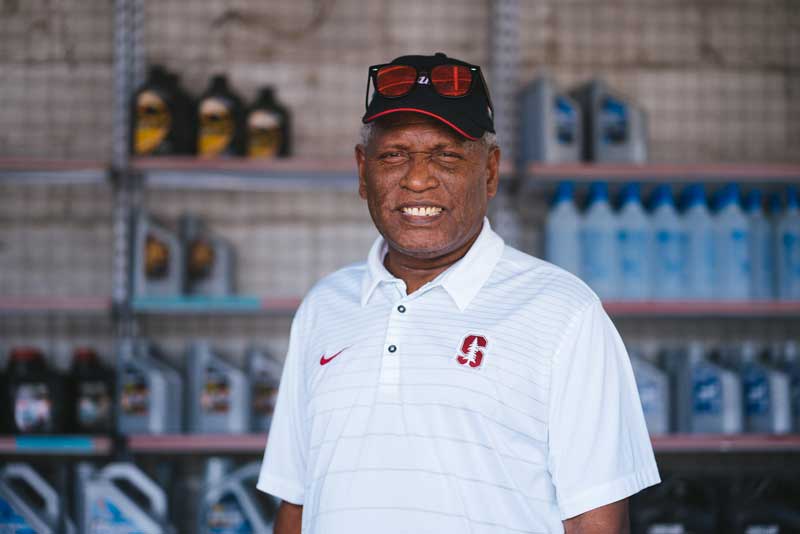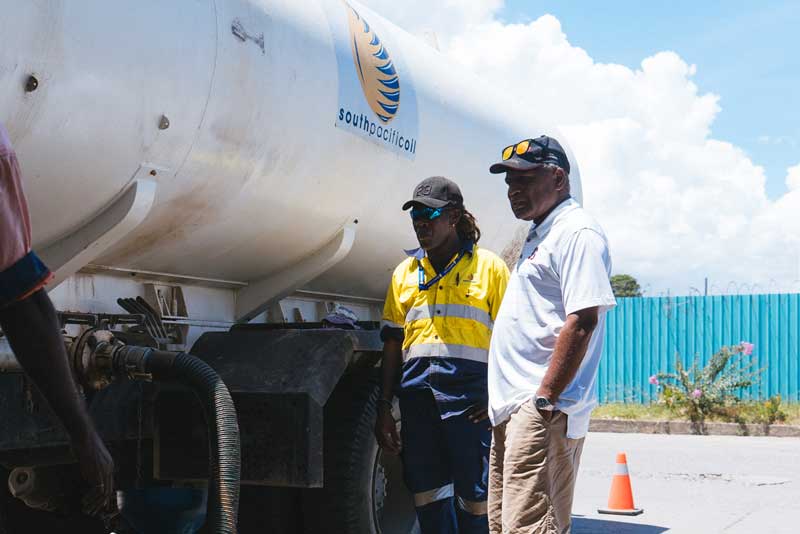Nesta Nelo, a 36-year-old Solomon Islander who works as an accounts officer at a busy print shop in Honiara, the capital, is resigned to paying a high price for electricity to keep the presses running. “We can’t stop the business,” she says.
But at home, it’s a different story. The cost of power puts it out of reach for her family. “Currently, we don’t use power,” she says. “We just use candles, torches, and lamps.”
Nelo’s struggle to afford electricity for her family is shared by many in this South Pacific Island nation. The Solomon Islands depends almost entirely on imported diesel for its energy needs—and citizens pay among the highest prices in the world for electricity.

Nesta Nelo in her print shop in Honiara, the capital of the Solomon Islands. © Peter Rae/IFC
“Everything in Solomons relies on fuel,” says service station owner Toata Molea. The cost of electricity is his biggest overhead. In just one month, he spends the equivalent of $6,400 on electricity – more than most people on the islands earn in a year.
Jay Bartlett, the chairman of the Solomon Islands Chamber of Commerce and Industry, believes that high energy costs are directly affecting the bottom line of many businesses. “It slows down our ability to grow because we’re paying so much on our operational costs,” he says. “There’s less availability of finances to put into capital expenditure. It stagnates the private sector.”
But now, there’s a renewable-powered light at the end of the tunnel – because of a pioneering public-private partnership (PPP) worth over $200 million. IFC acted as lead transaction advisor to the Government of the Solomon Islands and helped put in place the PPP with project preparation, the investor selection process, negotiation of project agreements, and the final financing agreement package.
When completed and operational in 2024, the 15-megawatt Tina River Hydropower Project is expected to curb the island nation’s reliance on imported diesel by almost 70 percent, greatly reduce greenhouse gas emissions, and deliver cheaper, cleaner power for Solomon Islanders like Nelo and Molea.

For Toata Molea, a service station owner in the Solomon Islands, the cost of electricity is his biggest expense. © Andrew Bouro/IFC
Opening the door to investment
The Tina River Hydropower Project is the first large-scale infrastructure project to be developed as a PPP in the Solomon Islands. The Prime Minister of the Solomon Islands, Manasseh Sogavare, describes it as “historic.”
“It will deliver cheaper power to the people of Solomon Islands and signals to investors that Solomon Islands is ready for large projects and partnerships. This first public private partnership infrastructure project in Solomon Islands opens the door for more, which will support much needed development, offering our people a better standard of living and more opportunities,” Sogavare says.
Under the terms of the PPP, Tina Hydropower Limited (THL), the Tina River Hydropower Development Project company, formed by Korea Water Resources Corporation (K-water) and Hyundai Engineering Co. (HEC) will build, own and operate the hydropower plant on the Tina River, 20 kilometers southeast of Honiara.

The financial package for the Tina River Hydropower Project includes funding from the World Bank’s International Development Association (IDA), the Green Climate Fund, the Republic of Korea’s Economic Development Cooperation Fund (EDCF), the Asian Development Bank (ADB), the Abu Dhabi Fund for Development (ADFD), and the Australian Government. With construction now set to begin early 2020, the total project cost is estimated to reach $240 million over the next five years.
The backing from the six entities was sought after the original plan to set up a hydropower project financed solely by the private sector was reconsidered. At that time (2014 to 2015), a steep drop in global oil prices made power generation by hydro a less competitive proposition to the private sector, says the project’s chief investment officer, Shobana Venkataraman, who led IFC’s work.
That strategy shift was just one of the many changes that took effect since the project was first conceived more than 10 years ago. For example, the planned location of the hydropower plant changed three times until its current spot was finalized.

Solomon Islands depends almost entirely on imported diesel for its energy needs.
The World Bank has been actively supporting the Tina River Hydropower Development Project since 2008. Work included identification of potential renewable energy sources, feasibility studies for potential project locations, providing assistance to the government to secure funding for the project, and facilitating agreements that will ensure the project can deliver power to the electricity grid. IFC signed the mandate to advise the government in 2009. The Multilateral Investment Guarantee Agency (MIGA), a member of the World Bank Group, is providing risk insurance.
The World Bank also helped set up a landowner participation arrangement – the first of its kind in the country – which will see the sharing of royalties through cooperatives, benefiting more than 4,000 people from communities around Tina River, including women and children. The arrangement is expected to lead to the establishment of new community development funds, and investments to improve community water and electricity infrastructure.
Better Prices, Better Quality of Life
As the Tina River Hydropower Project moves ahead, Venkataraman believes Solomon Islanders can look forward to more reliable and cheaper, cleaner electricity – as well as a steady price for power, unaffected by global economic swings.
The quality-of-life improvement that affordable electricity might bring is no abstraction to Eva Citro. The 36-year-old logistics manager at Ideka Furniture & Decoration Company in Honiara is already looking forward to cheaper power prices. Electricity is a significant operating expense and she believes that if the cost falls, the company could invest the money saved in its business.

Electricity is a significant operating expense for Eva Citro’s furniture and décor business. © Peter Rae/IFC
“Probably we would spend it raising the wages,” she says. “Then we’re going to use some, maybe, for air conditioning--because it’s hot over here, and customers complain.”
IFC’s transaction advisory work with the government was implemented in partnership with the governments of Australia and New Zealand under the Pacific Partnership. Australia, New Zealand, and IFC are working together through the Partnership to stimulate private sector investment and reduce poverty in the Pacific. Additional partnership support was also received from DevCo, a multi-donor facility affiliated with the Private Infrastructure Development Group (PIDG), with additional funding from the Netherlands and Sweden.
Join the conversation: #IFCimpact
Published in December 2019
